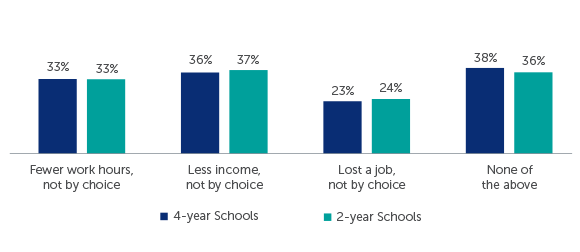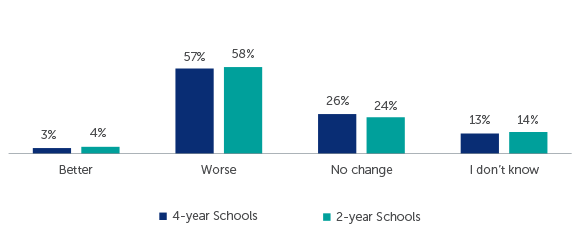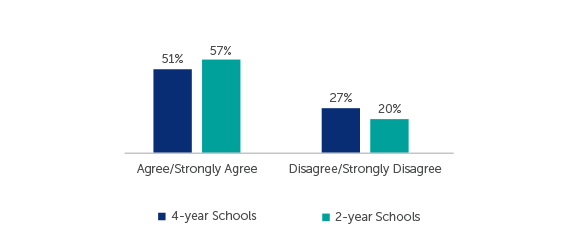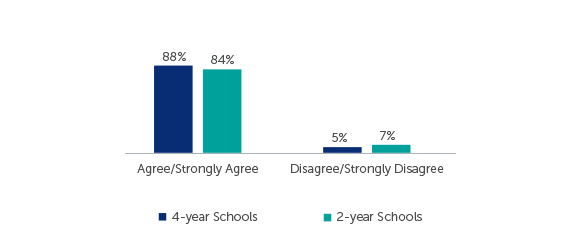
COVID-19-related changes in employment status were relatively similar across the two sectors. (Q32-35)
- Approximately one-third of students across both sectors worked fewer hours, not by choice, and 36 to 37 percent of four- and two-year respondents, respectively, indicated they had earned less income, not by choice.
Many students indicated their family’s financial situation had worsened since the start of the COVID-19 outbreak. (Q31)
- Fifty-eight percent of two-year respondents and 57 percent of four-year respondents indicated that their family’s financial situation had worsened since the start of the COVID-19 outbreak.
- Parenting students, first-generation students, Black/African American students, and Hispanic students were more likely to experience shocks to their family’s finances.
Respondents at two-year institutions were slightly more likely to experience an increased obligation to support their family financially (compared to before the pandemic). (Q30)
- Fifty-seven percent of two-year respondents agreed or strongly agreed they had more of an obligation, compared to 51 percent of respondents at four-year institutions.
Most respondents suffered mental and emotional tolls due to the pandemic. (Q29)
- At two-year institutions, 84 percent of respondents reported the coronavirus (COVID-19) outbreak added to [their] levels of stress, anxiety, or depression. This was slightly higher at four-year institutions, where nearly nine in ten (88 percent) indicated their mental health had been negatively affected by the pandemic.
Q32-35: Did the coronavirus (COVID-19) outbreak of 2020 change your work/income situation?

Q31: Since the coronavirus (COVID-19) outbreak of 2020, how would you describe your family’s finances?

Q30: I have more of an obligation to support my family financially compared to before the coronavirus (COVID-19) outbreak of 2020.*

*Responses indicating ‘Neutral’ are not shown
Q29: The coronavirus (COVID-19) outbreak of 2020 added to my levels of stress, anxiety, or depression.*

*Responses indicating ‘Neutral’ are not shown
Institutions can provide targeted emergency aid to students by coordinating efforts, consolidating resources, promoting the availability of aid, and addressing student needs holistically.
Without their normal social support networks available, many students struggling with stress and anxiety need access to mental health support.
Problem:
In addition to the normal pressure of balancing school, work, and family obligations, students struggle with keeping their focus on academics during this pandemic. Social distancing and quarantines further disrupt formerly reliable networks of support, leaving students vulnerable to mental health challenges.
Solution:
Institutions can provide students with mental health support, such as access to free or reduced-cost mental health services, medical counseling, mental health teleconferencing, and virtual support groups. They can enhance on-campus offerings or partner with local organizations to provide these services.
Students forced into virtual learning environments need adequate technical support.
Problem:
The reliance on virtual learning puts a premium on having adequate technology. But not all students will have the proper technical setup, especially students with inadequate financial means. This can lead to academic difficulties, alienation, and potentially stop-out.
Solution:
Institutions can use call campaigns and surveys to gauge the technological needs of their students and use innovative solutions to address those needs. Potential interventions include mailing coursework to students, renting laptops and/or wireless routers to students, and installing routers in on-campus parking lots.59
Solution:
Institutions can partner with internet service providers to help their students find low-cost options to fulfill their Internet and/or Wi-Fi needs, or offer students vouchers to cover the cost of these services. Households that meet certain criteria, including having a member receive a Federal Pell Grant during the current award year, may be eligible for discounted broadband service through the Emergency Broadband Benefit Program.60
During times of crisis, students need sensitive and appropriate communication with their institution.
Problem:
Crisis can lead to chaos without good communication. Poor communication can cause confusion and anxiety that can hinder student success.
Solution:
During a crisis, staff should demonstrate empathy and extend expressions of care and concern. Given the amount of information students may need to process, not all messaging needs to encourage students to act. Crisis communication should be evidence-based and share information from high-quality, trusted organizations.61 During COVID-19, institutions should consider sending information sourced from the Centers for Disease Control and Prevention and World Health Organization. In addition, leadership should have clearly defined crisis communication roles and consistently follow those roles to maintain clear communication.62 Text messages should be personalized; research suggests students prefer consistent, personalized communication directly from their institution over generic communication.
Trellis Company Webinar, Delivering Emergency Aid Services During COVID-19:
https://youtu.be/uSj3GoAFUS0
